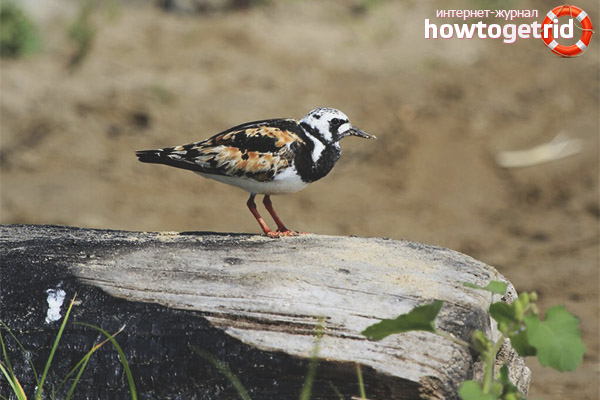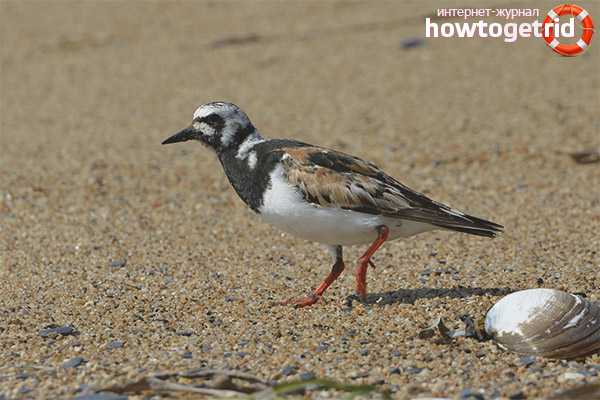The content of the article
Kamensharka is a small sandpiper, the size of a thrush. The body length of an adult bird ranges from 20-27 cm, the wingspan is 38-47 cm. Weight varies during the year and usually is 70-160 gr.
Appearance
- The black cone-shaped beak is thin, small and slightly upturned, in shape resembling the beaks of sparrows and ravens.
- Small yellow-orange paws, on which the stone fan prefers to stand in turn.
- Big head and not too long neck, slightly rounded body.
- During nesting, they look bright: a white bottom, and on the back and wings a complex pattern of white-black-red areas.
- There is a clear black and white pattern on the head and chest.
- By autumn, the red areas lose their saturation, becoming brown, and then the bird from a distance looks gray-brown with light areas.
- The plumage of males during the mating season is slightly brighter and more expressive than that of females.
Spread
Habitat
Prefer not wetlands with rocky shores, cliffs and tall grass, where it is good to hide their nests. Often found near pebble beaches and river islands. Rarely settle near fresh water.
Food
Kamensharka feed on bugs, flies, worms, butterflies, dragonflies, insect larvae, mollusks, small crustaceans. They can eat small fish, but they cannot swim. Often eat plant foods: berries, grains and seeds. Sometimes they seek food in landfills, they rarely eat carrion left on the seashore, and do not disdain eggs from other nests.
Activity

Due to the method of fodder extraction, the activity of stone chambers is manifested mainly in the daytime. But in areas with a round-the-clock day, birds seek food at any time.
Behavior
Stones are active and extremely mobile birds. Looking for food, they move along the shore with short jumps, looking under small objects. In the process of feeding, they calmly and non-conflict contact with other birds looking for their food. Nests are built in single pairs and colonies, with large distances between sites, but to protect nesting sites they do not cooperate with each other.
Lifestyle
Kamensharka are the first among their squad to fly to nesting sites. Usually in mid-May - early June, depending on the specific region. Individuals of both sexes return to their nesting places together, often restoring the previous pair. Docking is practically absent. Something similar to him happens when a male flies to his site, driving off another. Each male guards the territory belonging to him, frightening off predators with threatening poses and warning trills.
The nest is arranged on a dry site near the seashore in the grass or between stones. The male digs a few holes and shows them to the female, who first ignores the entire construction process, but, in the end, chooses a specific place for laying eggs. The nest is a small hole, a little covered with dry leaves, needles and other plant debris. It is located near a stone or log, slightly covered with grass or branches of a bush.From May to July 4, less often 3, olive or grayish spotted eggs are laid. Hatching lasts 23-28 days, and both birds participate in it. In the process of guarding the nests become aggressive and attack predators. Both partners take care of the chicks, or only the male.
Hatched birds are ready to fly on 23-26 days. Soon after that they fly away for the winter. The adult females are the first to leave the nesting sites, then the adult males, and only then the young stone-haired ones.
Interesting Facts
It happens that kamensharka engaged in robbery. Seeing an unprotected nest, they peck a small hole in the eggs left there and drink their contents. The nesting places of gulls, terns, ducks, and sometimes even other stone reptiles are subjected to terror.
Kamensharka are rarely found on the territory of its range because of their scarcity. The view is included in the protection lists of some international conventions.
Video: Rockstone (Arenaria interpres)











Submit